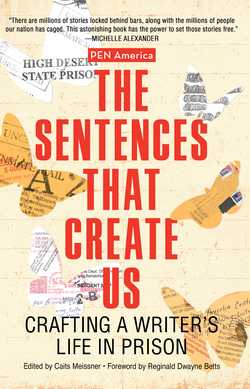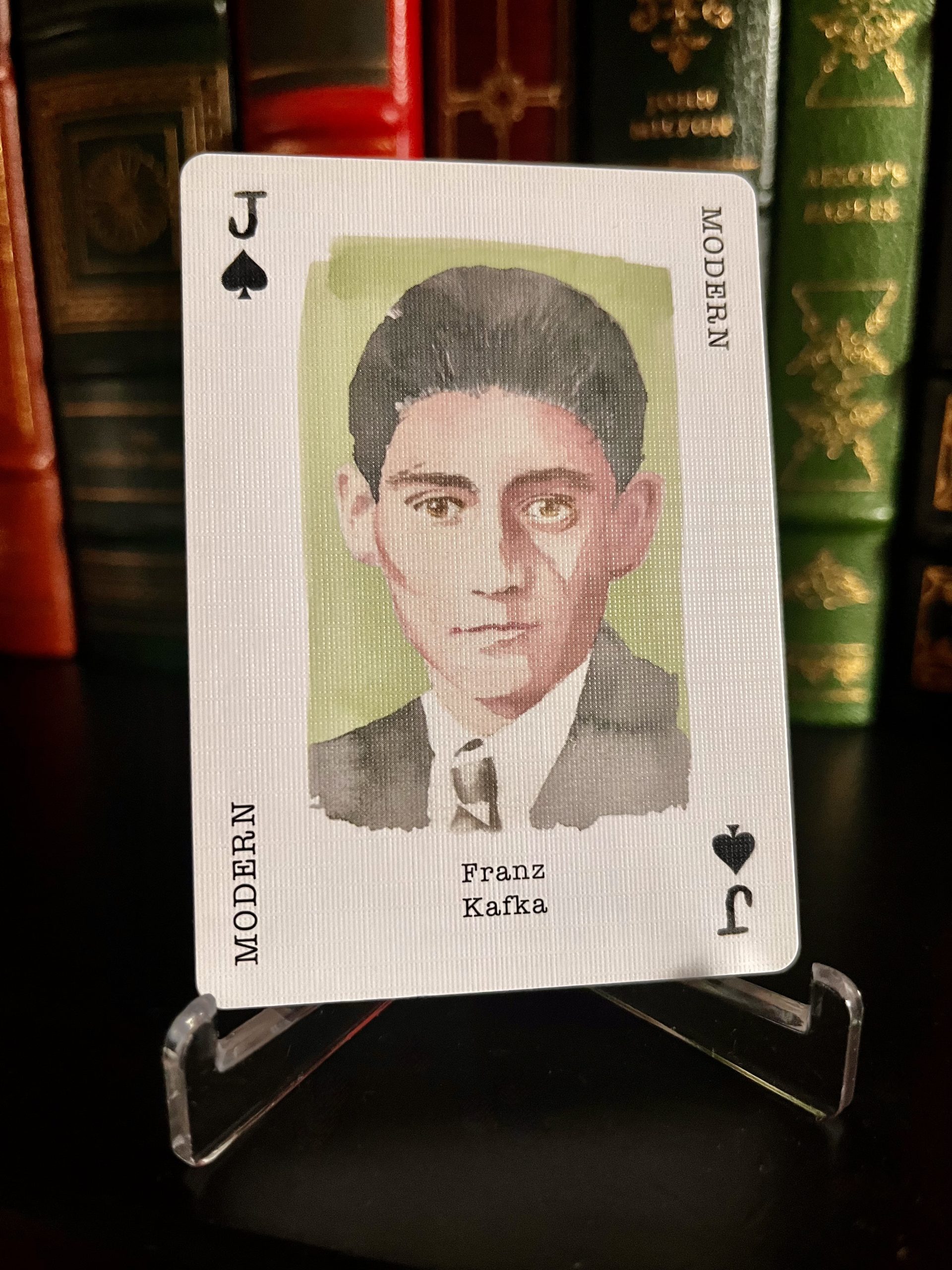interviews
A Handbook for Creating a Literary Life in Prison
Caits Meissner, editor of "The Sentences That Create Us," on how the literary community can support prison abolition

How do you start writing when you’re incarcerated in prison? How do you establish a literary life without access to craft workshops, the internet, or even to the outside world?
The Sentences That Create Us: Crafting a Writer’s Life in Prison, PEN America’s new writing handbook, addresses those questions to serve as “a road map for incarcerated people and their allies to have a thriving writing life behind bars.” In addition to providing guidance on developing a personal and professional writing life while incarcerated, The Sentences That Create Us provides introductions to the foundations of writing, strategies for addressing trauma in writing, as well as writing exercises developed by prison educators.
I spoke to Caits Meissner, the director of the Prison and Justice Writing at PEN America, about the ways in which the literary community should support abolition work and how The Sentences That Create Us functions as an organizing and self-empowerment tool.
Editor’s note: Deirdre Sugiuchi will be moderating a panel, Time Has Come Today, with Caits Meissner, Caleb Gayle, CT Mexica, and Deb Olin Unferth about writing imprisonment, incarceration, and social change at AWP in Philadelphia on March 26th 2022.
Deirdre Sugiuchi: How did you put this book together?
Caits Meissner: While I admired the former handbook (the predecessor to Sentences), it wasn’t responsive to the needs of people in prison. It was a craft book. I thought, “What differentiates this? Other than that it exists and is directed towards incarcerated people, but 10 years later now, we’re in a different place in society, having different conversations, and mass incarceration is a huge conversation.”
When I started this work, it was just myself and one other colleague. We were going through the hundreds of hundreds of letters we would get every week, and started to see what people were asking for. Certainly people wanted to understand how to write, but what they really wanted to understand was the business of writing, and they wanted to understand what they needed to do to participate as a literary community member. They wanted to understand if other people were writing in prison and what that looked like—you have to imagine that when you’re in prison, you don’t have the internet. You might have an email platform where you can send one email that is censored and looked at by the Department of Corrections, but you live in a vacuum. It’s not like us where we jump on Twitter and see the whole landscape exploding.
DS: What are the challenges of writing while in prison?
CM: Alone time and quiet is non-existent in prison—imagine writing on a tiny bunk with the toilet next to you and potentially your roommate going to the bathroom as you try to type. The first challenge is just being able to block out all of the noise. Larger challenges include all the things that prison does to a person: writing through all of the regret, guilt, anger, frustration, being separated from loved ones, the psychological drama.
What’s hard to grasp is censorship. Everything that comes in and out of the prison mailroom is read, reviewed and censored by a random mail clerk. Often when incarcerated writers publish their work, it comes with punitive results. I had a great deal of anxiety when the book came out about some of the authors being targeted by their administrations, being put into solitary confinement, being seen as a threat for exposing harm, being dropped from jobs or programs. I had somebody who won our contest with a piece about the mental health board he worked with in the prison. For him, that job was a way to give back in the context of prison, and because he wrote about the trouble, he was removed from that job and he had to fight to get his job back.
The folks that I work with are really persistent and have really decided on a soul level that I’m not gonna stop no matter what. The abuse they end up taking is really beyond my comprehension.
DS: We’re talking about adults who are cut off from everything.
CM: I’ve been to over 23 prisons at this point across the country. I go in multiple times a week, you lock your cell phone, you go to the metal detector. I’ll be three, four, five hours in a prison without technology, and I still cannot imagine what life in prison is like. Even reading all the stories, having multiple colleagues and friends being in the facilities for years, and it’s still beyond my imagination, how incredibly disconnected people are. I think what I started to understand with this book was that there was a real opportunity to think about the various things that people are asking for and need in prison, and also on the outside, we’re really interested in working with folks inside.
In 2018, I went to the Minnesota Prison Writers Workshop, one of my favorite organizations. A lot of people were excited about PEN America—they know the writing contest—but Zeke Caligiuri was like, “Cool, PEN America. I wanna tell you about the writing collective we started before anybody was here.” I thought it was gripping. Zeke Caligiuri’s “On Building Prison Writing Communities” really was the first essay idea I had for the book. I said, “We’re going to do introductions to each genre because that’s part of this, but I want them to speak to prison as much as possible—the experience of writing through trauma, using an example from justice-involved authors, not solely, but enough that people see the community of the space just through the book and how the names echo through the text, and who is referencing who…”
That’s the driving energy of this collection. It has to be helping folks on every end of the spectrum, the lower case writer who says, “I want to write better letters to my girlfriend,” the incarcerated person who’s working on their legal work and wants to understand, “I’m going to the board, how do I tell my story? I wanna come home.” This book ultimately is about getting people home from prison, metaphorically and literally.
DS: How did you choose the contributors?
CM: I reached out to long-time prison educators I knew and said, “Give me your best piece and offer a little pedagogy in it as well.” I also wanted a writing collection that’s inspired to form based on the scope in prison, to understand the context of the room in which these things happen as well. My work as an editor was very hands-on. I was saying, “Piper Kerman, can you write about writing about people you know, because you wrote Orange is the New Black?”
This book is an organizing tool, it’s a self-empowerment tool, it’s a life-giving tome, it is a book full of life, and any spirit of life in prison is crushed.
I was asking, “What can we do to make something that’s never been made before, seen before, written before about these tried and true topics?” We had to cut 200 pages out of the original draft; there were so many other people I wish I could have included. A lot of our work was trying to both keep some of the echoes of the text intact and also really trying to carve each essay, really figuring out how to get it to its most sharp, unique offering to really get a taste of what writing can do in prison and out of prison as well.
DS: In the introduction, you write that one of your goals was to develop approaches to address trauma in writing, in a way to support an authentic journey, accountability, and restoration. Can you discuss?
CM: I think first and foremost, what the contributors in this book were really generous with was saying that this kind of writing is really hard. You look at a chapter like “On Non-Fiction Memoir” by Patrick O’Neil where he is saying, “Here are the traumas that came up for me in writing my memoir, which had to do with addiction and death,” and what it takes to hold yourself through that. Sarah Shourd wrote in “On Dramatic Theater” about being in solitary confinement for a year overseas, and then coming home and writing a play about solitary and interviewing people, and literally having to go under the covers and hide from herself during it.
What I think is such a bomb in reading those particular excerpts is they say writing is going to bring you into very painful moments, how do you stay with the feeling without losing yourself? How do you create safety in a completely unsafe environment where your cellmate might honestly try to kill you? How do you build psychological safety, in a place that is fundamentally the exact opposite of safe?
These writers talk about what writing can do for us—create an internal life of the mind that becomes a parallel world to the one you’re living in physically, and that reality creating is phenomenally powerful. I think in order to address harm you’ve done and harm done to you, both heavy things, you need some baseline of safety to go there. I think writing can provide a path, and especially within a book like this where you’re living it alongside people who are opening up their path to be able to really strengthen the mind.
DS: What are your hopes for the book?
CM: My dreams for this book are big and they’re already happening. We have 75,000 copies we’re working on distributing to prisons. We’re looking to start these writing group pilots to help us develop this curriculum in tandem with leaders in the field. I see this book getting into the hands of public defenders, helping their clients to understand how to better write for their cases. My hope is that it is a comfort and an inspiration for people behind the walls, but my bigger hope is that the book will start to change the culture. That’s a lofty goal, but I think it’s possible with the community around it. My sense is that this book will help the literary community be on the cutting edge of abolition work at its core, that’s not me speaking as a PEN America representative, we’re a free expression org, but as Caits.
My hope is that it is a comfort and an inspiration for people behind the walls, but my bigger hope is that the book will start to change the culture.
I hope that also the literary community continues to be excited by that charge and instead of being kind of… “Yeah, abstractly, I support anti-mass incarceration movements,” that people start to think: we have 2.3 million people currently incarcerated, which means we have millions and millions and millions, if not billions of people affected by incarceration—family, friends, communities, plus all the people that have come home from prison, plus, people on probation and parole. The apparatus of mass incarceration, the influence of it, is so deep and so wide and so vast on levels people don’t even realize.
I’d like to see a completely different way of dealing with harm in our world. I think prisons are just dungeons, they’re horrible soul-sucking places. This book is an organizing tool, it’s a self-empowerment tool, it’s a life-giving tome, it is a book full of life, and any spirit of life in prison is crushed. My hope for this book is that it builds movements and the rightful leaders of movements. I hope this inspires them.
DS: How can the literary community support anti-mass incarceration movements?
CM: There are many ways to be involved in this movement—from writing about the topic, to supporting the work of incarcerated writers, to keeping the conversation alive in your communities or homes, to bringing guest speakers into your workplace.
Often people get sparked and want to volunteer and they find the organizations are overloaded with volunteers. I always say look locally to organizations like Books Through Bars and local reentry programs, even local prisons and jails to see where your volunteer efforts can make a difference. If there aren’t any organizations in your area, start local efforts, especially in areas where you’re outside of a big city. Big city prisons are full of volunteers because creative people flock to cities, but once we get out into the woods, so to speak, those opportunities really dry up.
I also think it’s wonderful to have themed issues about mass incarceration, but it’s perhaps even more wonderful when we incorporate justice-involved writers, formerly and currently incarcerated, into our publications, welcoming people into the larger literary community, really opening space and operating from a standpoint of radical inclusivity.









